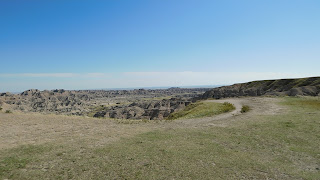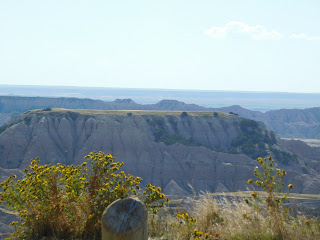I often wonder how the US can have so many different
terrains, from rolling fields to canyons to desserts and high mountains, the US
has it all.
One of its great beauties is the Badlands National Park. So awe inspiring,
so beautiful, and so diverse.
We had toured it briefly when in the area in 2006, but this
trip we decided to actually go down into the park and truly see and experience
it. The day was bright and sunny as we
entered the park through the only toll booth on the various entrances to the
park. Haven’t quite figured out why
there is a fee at that entrance, but none of the others.
It didn’t really matter because our National Parks Pass covered the entry fee and we were waved right through.
SHOESTRING TRAVELER NOTE: I just read several news stories from various newspapers that say the price of the senior lifetime national pass will be going up to $80 from $10 by the end of the year. More research needs to be done on this to verify it. However, if you are delaying getting your senior national park pass you might want to go ahead and order it online now to save $70.
The area we started in looks flat as you drive along the
winding road when suddenly the earth falls away from you on both sides of the
road to show you amazing vistas of mesas/plateaus
, columns and far off rolling plains.
At this point we also realized that the wind had picked up
immensely, as in “don’t get too close to the edge you could get blown off”
immensely. It was a wind that was to
stay with us the entire day. The wind
had an energy draining effect on us to the point the last few stops we simply
enjoyed the view from the inside of the truck.
Yet we wanted to see it all.
As we battled the wind and looked out over the valley we
could see that the wind is probably a very common occurrence. One that has worn away the land over a
millennium.
Almost immediately after the very rough terrain the valley
fell to a more rolling terrain.
Then slowly to more structured mesas/plateaus.
In one area we read an information kiosk that
talked about how the flat tops of the mesas would grow lush grass, but the
cattle couldn’t climb the steep walls of the mesa to get to it. So every year the farmers would work together
disassembling their hay bale making equipment.
Climb the steep walls and manually pull the equipment up a piece at a
time.
They would then harvest the crop of hay. Reversing
their climb they would lower the pieces of the equipment and the bales of hay
down to the valley. Where they would
load it onto wagons to take it to their farms for winter storage.
Things like this in our history make me wonder how we
survived at all.
As we drove along it was generally one of these three types
of areas. Occasionally we would come
across some wildlife, such as this old fellow, who looked like he had seen
better days. We spent several minutes watching him slowly amble down the side
of the road. We saw many, much younger
and healthier looking bison during the rest of the day throughout the park.
One of our favorite areas for wildlife was the enormous
prairie dog town we stopped at as we toured.
It had probably grown 10 fold in size since we were there in 2006. It
now went on for miles and miles.
A video of our visit to Roberts Prairie Dog Town, and some of its inhabitants can be viewed here.
You can camp in the valley of the park in a very basic
manner. As you can see the various
campground areas or modest, but efficient. While we can, and often do, boondock
the long winding drive down into these campgrounds wasn’t in our camping game
plan. Some campgrounds you just have to
forgo when your fifth wheel is 37 ft long.
We had chosen to just pack a picnic lunch, but ended up
eating it in the truck due to the wind.
As we drove through the park we saw so much beautiful
terrain we were reluctant to leave, but the sun was setting and it became time
to go. On our way out Gary caught a very
brief glimpse of a white wolf. By the
time he got the camera it was gone disappearing into the oncoming darkness.



















No comments:
Post a Comment